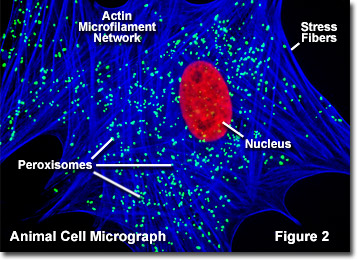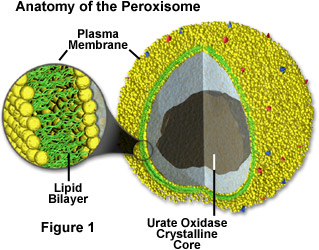Peroxisomes (also called microbodies) are organelles found in virtually all eukaryotic cells. They are particles of about 100-500 nm with a single membrane that surrounds an electron dense matrix
They are involved in different activities:
- catabolism of very long chain fatty acids, branched chain fatty acids, D-amino acids, polyamines
- biosynthesis of plasmalogens, etherphospholipids critical for the normal function of mammalian brains and lungs.
- in liver cells, detoxify alcohol and other harmful compounds by transferring hydrogen directly to oxygen (oxidases that generate the harmful H2O2).
- hydrogen peroxide (a common byproduct of cellular metabolism) degradation by Catalase.
- synthesis of unsaturated fatty acid
- production of bile acids
- It is still debated if peroxisomes are involved in isoprenoid and cholesterol synthesis in animals
More details..
Peroxisomes
 ...
... 
Peroxisomes at Molecular Expression
In order to carry out their activities, peroxisomes use significant amounts of oxygen and also contain approximately 10% of the total activity of two enzymes in the pentose phosphate pathway, which is important for NADPH synthesis.
This characteristic of the organelles would have been extremely important millions of years ago, before cells contained mitochondria.
Peroxisome content
!http://rpi.edu/dept/bcbp/molbiochem/MBWeb/mb2/part1/images/peroxi.gif"

The paracrystalline electron-dense inclusions are composed of the enzyme urate oxidase (not in man and prymates)
The peroxisomal enzyme Catalase degrades H2O2 by the reaction:
2 H2O2 � 2 H2O + O2
Import into Peroxisome

All peroxisomal proteins are synthesized at free ribosomes and are post-translationally transferred to the cytosol and imported into the peroxisomes. To this end, the newly synthesized proteins contain so-called peroxisomal targeting signals (PTSs) that are recognized by cytosolic receptor proteins for binding and guidance of the cargo to the peroxisomal membrane, a process that requires a number of additional proteins. Almost all matrix proteins have a type 1 PTS at their carboxyl terminus, specifically recognized by a receptor called Pex5p. Pex5p then binds to Pex13p, which is an integral membrane protein of the peroxisome.

from Dr. Ralf Erdmann site
Peroxisomes genesis
Peroxisomes are organelles that probably derive from the endoplasmic reticulum as donor organelle.

from The Peroxisome Biogenesis crew

Peroxisomes in Health and Disease

Peroxisome Biogenesis: Something Old, Something New, Something Borrowed 2010

Fatty Acids > 20 catabolism

Peroxisomal oxidation stops at 8 carbon atoms, so the octanoyl-CoA and acetyl-CoA products of peroxisomal lipid breakdown are converted to the corresponding carnitine derivatives and shuttled across to the mitochondria to complete their conversion to carbon dioxide and water.
from Integration & Compartmentation of Metabolism, dr. J.A. Illingworth
FAD is electron acceptor for peroxisomal Acyl-CoA Oxidase, which catalyzes the first oxidative step of the pathway. The resulting FADH2 is reoxidized in the peroxisome producing hydrogen peroxide:
FADH2 + O2 � FAD + H2O2
Brain Peroxisomes

Axons need glial peroxisomes, 2007
Peroxisomes Number Regulation

from Michael J. Schell : We are investigating the molecules that regulate the transcription of genes that control peroxisome proliferation. We use a combination of cell biology, molecular biology, and microscopy to understand the pathways controlling peroxisome number and function. This research has medical relevance to metabolic disorders, neuronal migration, myelination, and Alzheimer's disease. We try to control peroxisome numbers in astrocytes via drugs that regulate cholesterol homeostasis in cells